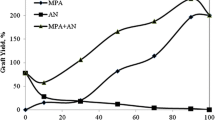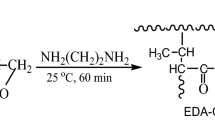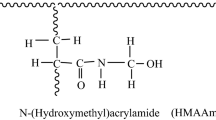Abstract
Grafting of 2-hydroxyethyl methacrylate (HEMA) on poly(ethylene terephthalate) (PET) fibers was carried out via free-radical polymerization technique using benzoyl peroxide as initiator. The obtained copolymers were examined by scanning electron microscope and Fourier-transform infrared spectroscopy analysis, and it was proved that HEMA was successfully grafted onto the PET structure. The synthesized fibrous adsorbents were used to remove Congo red (CR) from aqueous solutions by batch adsorption method. The effects of pH, grafting yield, operation time and dye concentration were studied to find optimal conditions for adsorption of CR by the HEMA-grafted PET (PET-g-HEMA). The obtained results showed that the amounts of adsorbed dye on the PET-g-HEMA lowered with increasing pH. At pH 2, the dye amount adsorbed by the fibers increased with increasing dye concentration up to 70 ppm and grafting yield up to 110%. It was also seen that the adsorption had considerably rapid kinetic and achieved equilibrium within 60 min. The maximum removing abilities of the grafted fibers was found to be 16 mg/g when the beginning concentration of CR was 70 ppm at pH 2. The dye was desorbed from the loaded fibers with 1 M NaOH solution, and it was found that 83% of the adsorbed dye was recovered. The investigations on reusability of the PET-g-HEMA fibers showed that the constructed fibers can be used at least five times without losing adsorption capacities for CR. All these results indicate that the grafting can be used to remove the anionic dyes from the aqueous solution.










Similar content being viewed by others
References
Chen H, Zhao J (2009) Adsorption study for removal of Congo red anionic dye using organo-attapulgite. Adsorption 15:381–389. https://doi.org/10.1007/s10450-009-9155-z
Chiou MS, Ho P, Ho Y, Li HY (2004) Adsorption of anionic dyes in acid solutions using chemically cross-linked chitosan beads. Dyes Pigments 60(1):69–84. https://doi.org/10.1016/S0143-7208(03)00140-2
Ho YS, Chiang CC (2001) Sorption studies of acid dye by mixed sorbents. Adsorption 7(2):139–147
Gong R, Ding Y, Li M, Yang C, Liu H, Sun Y (2005) Utilization of powdered peanut hull as biosorbent for removal of anionic dyes from aqueous solution. Dyes Pigments 64(3):187–192. https://doi.org/10.1016/j.dyepig.2004.05.005
Hameed BH, El-Khaiary MI (2008) Equilibrium, kinetics and mechanism of malachite green adsorption on activated carbon prepared from bamboo by K2CO3 activation and subsequent gasification with CO2. J Hazard Mater 157:344–351. https://doi.org/10.1016/j.jhazmat.2007.12.105
Gupta VK, Ali I, Suhas Mohan D (2003) Equilibrium uptake and sorption dynamics for the removal of a basic dye (basic red) using low-cost adsorbents. J Colloid Interface Sci 265(2):257–264. https://doi.org/10.1016/S0021-9797(03)00467-3
Purkait MK, Maiti A, DasGupta S, De S (2007) Removal of Congo red using activated carbon and its regeneration. J Hazard Mater 145(1–2):287–295. https://doi.org/10.1016/j.jhazmat.2006.11.021
Vimonses V, Lei SM, Jin B, Chow CWK, Saint C (2009) Kinetic study and equilibrium isotherm analysis of Congo red adsorption by clay materials. Chem Eng J 148(2–3):354–364. https://doi.org/10.1016/j.cej.2008.09.009
Zhou Y, Ge L, Fan N (2018) Adsorption of Congo red from aqueous solution onto shrimp shell powder. Adsorpt Sci Technol 36(5–6):1310–1330. https://doi.org/10.1177/0263617418768945
Neamtu M, Yediler A, Siminiceanu I, Macoveanu M, Kellrup A (2004) Decolorization of disperse red 354 azo dye in water by several oxidation processes—a comparative study. Dyes Pigments 60(1):61–68. https://doi.org/10.1016/S0143-7208(03)00129-3
Abdullah AZ, Salamatinia B, Kamaruddin AH (2009) Application of response surface methodology for the optimization of NaOH treatment on oil palm frond towards improvement in the sorption of heavy metals. Desalination 244(1–3):227–238. https://doi.org/10.1016/j.desal.2008.06.004
Zeng GM, Cheng M, Huang DL, Lai C, Xu PA, Wei Z et al (2015) Study of the degradation of methylene blue by semi-solid-state fermentation of agricultural residues with Phanerochaete chrysosporium and reutilization of fermented residues. Waste Manag 38:424–430
Arslan M, Günay K (2017) Synthesis and characterization of PET fibers grafted with binary mixture of 2-methylpropenoic acid and acrylonitrile by free radical: its application in removal of cationic dye. Polym Bull 74:1221–1236. https://doi.org/10.1007/s00289-016-1773-5
Yagub MT, Sen TK, Afroze S, Ang HM (2014) Dye and its removal from aqueous solution by adsorption: a review. Adv Colloid Interface 209:172–184. https://doi.org/10.1016/j.cis.2014.04.002
Rafatullah M, Sulaiman O, Hashim R, Ahmad A (2010) Adsorption of methylene blue on low-cost adsorbents: a review. J Hazard Mater 177(1–3):70–80. https://doi.org/10.1016/j.jhazmat.2009.12.047
Gupta VK, Suhas (2009) Application of low-cost adsorbents for dye removal—a review. J Environ Manag 90(8):2313–2342. https://doi.org/10.1016/j.jenvman.2008.11.017
Mittal H, Ray SS (2016) A study on the adsorption of methylene blue onto Gum ghatti/TiO2 nanoparticles-based hydrogel nanocomposite. Int J Biol Macromol 88:66–80
Mittal H, Ray SS, Okamoto M (2016) Recent progress on the design and applications of polysaccharide-based graft copolymer hydrogels as adsorbents for wastewater purification. Macromol Mater Eng 5(301):496–522
Arslan M, Günay K (2019) Application of 4-VP-g-PET fibers and its N-oxide derivative as an adsorbent for removal of cationic dye. Polym Bull 76:953–965. https://doi.org/10.1007/s00289-018-2400-4
Kaith BS, Jindal R, Mittal H, Kumar K (2010) Temperature, pH and electric stimulus responsive hydrogels from Gum ghatti and polyacrylamide-synthesis, characterization and swelling studies. Chem Sin 1(2):44–54
Arslan M (2010) Preparation and use of amine-functionalized glycidyl methacrylate-g-poly(ethylene terephthalate) fibers for removal of chromium(VI) from aqueous solution. Fibers Polym 11:325–330
Mittal H, Kaith BS, Jindal R (2010) Synthesis, characterization and swelling behaviour of poly(acrylamide-co-methacrylic acid) grafted Gum ghatti based superabsorbent hydrogels. Adv Appl Sci Res 1(3):56–66
Kumar K, Kaith BS, Jindal R, Mittal H (2011) Gamma-radiation initiated synthesis of Psyllium and acrylic acid-based polymeric networks for selective absorption of water from different oil–water emulsions. J Appl Polym Sci 6(124):4969–4977
Kaith BS, Jindal R, Mittal H, Kumar K (2010) Synthesis of crosslinked networks of Gum ghatti with different vinyl monomer mixtures and effect of ionic strength of various cations on its swelling behavior. Int J Polym Mater 61:99–115
Mittal H, Maity A, Ray SS (2015) Effective removal of cationic dyes from aqueous solution using gum ghatti-based biodegradable hydrogel. Int J Biol Macromol 79:8–20
Kevin L, Mao B, Cebe P (2014) Electrospun fibers of poly(ethylene terephthalate) blended with poly(lactic acid). J Therm Anal Calorim 116:1351–1359. https://doi.org/10.1007/s10973-013-3583-4)
Fragal VH, Cellet TSP, Pereira GM, Fragal EH, Costa MA, Nakamura CV, Asefa T, Rubira AF, Silva R (2016) Covalently-layers of PVA and PAA and in situ formed Ag nanoparticles as versatile antimicrobial surfaces. Int J Biol Macromol 91:329–337. https://doi.org/10.1016/j.ijbiomac.2016.05.056
Huang W, Jang J (2009) Hydrophilic modification of PET fabric via continuous photografting of acrylic acid (AA) and hydroxyethyl methacrylate (HEMA). Fibers Polym 10(1):27–33. https://doi.org/10.1007/s12221-009-0027-72-7
Ping X, Wang M, Ge X (2011) Surface modification of poly(ethylene terephthalate) (PET) film by gamma-ray induced grafting of poly(acrylic acid) and its application in antibacterial hybrid film. Radiat Phys Chem 80:567–572. https://doi.org/10.1016/j.radphyschem.2010.12.011
Kumar V, Jolivalt C, Pulpytel J, Jafari R, Arefi-Khonsari FA (2013) Development of silver nanoparticle loaded antibacterial polymer mesh using plasma polymerization process. J Biomed Mater Res A 101:1121–1132. https://doi.org/10.1002/jbm.a.34419
Coşkun R, Er E, Delibaş A (2017) Synthesis of novel resin containing carbamothiolylimidamide group and application for Cr(VI) removal. Polym Bull 3(75):963–983
Yigitoglu M, Arslan M (2009) Selective removal of Cr(VI) ions from aqueous solutions including Cr(VI), Cu(II) and Cd(II) ions by 4-vinly pyridine/2-hydroxyethylmethacrylate monomer mixture grafted poly(ethylene terephthalate) fiber. J Hazard Mater 166:435–444. https://doi.org/10.1016/j.jhazmat.2008.11.075
Yigitoglu M, Arslan M (2007) 4-Vinylpyridine and 2-hydroxyethylmethacrylate monomer mixture graft copolymerization onto poly(ethylene terephthalate) fibers using benzoyl peroxide. Polym Bull 58:785–798. https://doi.org/10.1007/s00289-006-0719-8
Wang W, Cheng W, Tian M, Zou H, Li L, Zhang L (2012) Preparation of PET/Ag hybrid fibers via a biomimetic surface functionalization method. Electrochim Acta 79:37–45. https://doi.org/10.1016/j.electacta.2012.06.063
Mittala H, Alhassana SM, Ray SS (2018) Efficient organic dye removal from wastewater by magnetic carbonaceous adsorbent prepared from corn starch. J Environ Chem Eng 6(6):7119–7131
Arslan M, Günay K (2018) Synthesis of amine-functionalized methacrylic acid-g-poly(ethylene terephthalate) fiber and its Congo red removal ability. Polym Bull 75:1701–1713. https://doi.org/10.1007/s00289-017-2121-0
Arslan M, Günay K (2017) Synthesis and use of PET fibers grafted with 4-vinyl pyridine and 2-methylpropenoic acid for removal of rhodamine B and methylene blue from aqueous solutions. J Polym Sci Appl 1:3
Author information
Authors and Affiliations
Corresponding author
Additional information
Publisher's Note
Springer Nature remains neutral with regard to jurisdictional claims in published maps and institutional affiliations.
Rights and permissions
About this article
Cite this article
Gün Gök, Z., Günay, K., Arslan, M. et al. Removing of Congo red from aqueous solution by 2-hydroxyethyl methacrylate-g-poly(ethylene terephthalate) fibers. Polym. Bull. 76, 6179–6191 (2019). https://doi.org/10.1007/s00289-019-02721-2
Received:
Revised:
Accepted:
Published:
Issue Date:
DOI: https://doi.org/10.1007/s00289-019-02721-2




